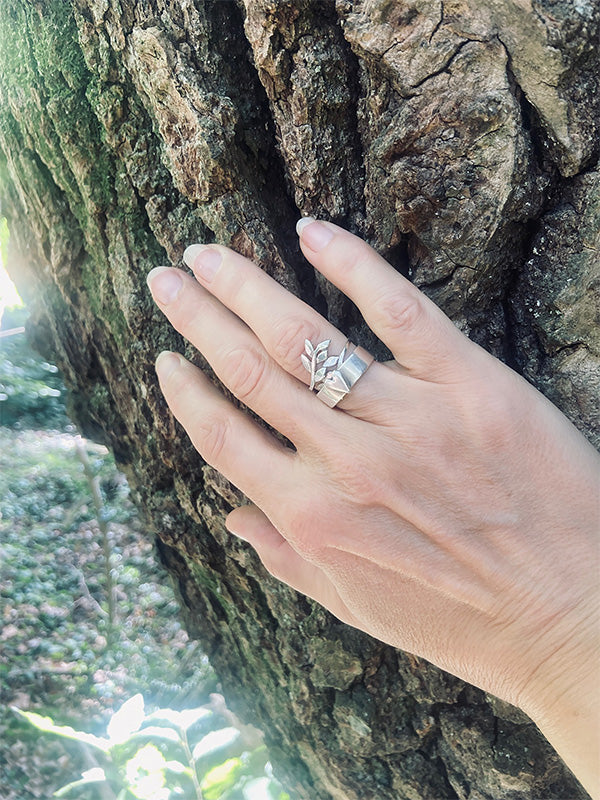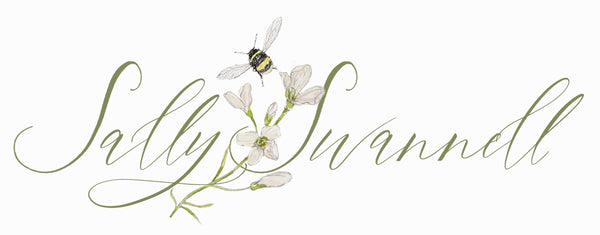
Unravelling & Rewilding
Share
You often hear people talk about the moment everything changed. For me, it wasn’t a single lightning-bolt event, but a slow unravelling, a series of insights that came over a period of five years. Life nudged me, sometimes gently, sometimes forcefully, into uncovering what was truly mine. It was often painful, but ultimately transformative.
In 2020, while the world was still reeling from the pandemic, strangely, my day-to-day life remained much the same. I was lucky — my family, friends, and neighbours were safe, and I still had an income. But the truth was, I had been working and living alone for nearly 15 years. Seven-day work weeks were the norm. I was lonely, creatively and emotionally burnt out, and grappling with depression.
At the time, I had a successful business producing artwork for greetings cards, stationery, and homeware. The comforting images of home I was creating gave me a sense of safety — it was the life I longed for. But inside, I felt lost. After the end of my marriage and the death of my mother, I often felt like a stranger to myself. Customers told me my work brought them feelings of nostalgia and belonging, and I loved that, but I also knew, deep down, that those were the very things I was missing.
I struggled with guilt. I was not on the frontline, my life had not been turned upside down in obvious ways. But quietly, I had been losing my sense of purpose for years. What I did know, without doubt, was that I felt a deep connection to the natural world, and I felt a growing urgency to play a role in protecting it.
So, I made some fairly drastic decisions: I closed my business and sold my home, which was far from easy — I loved both, but I knew I had to jump off the proverbial merry-go-round and make space for something new.
Over the following months, I began volunteering at local nature reserves, and a conversation with a reserve warden who had returned to university as a mature student planted an idea. A few months later, I had enrolled in a full-time foundation degree in wildlife conservation.
University turned out to be one of the most enriching experiences of my life. I made good friends, confronted my lifelong fear of public speaking, and discovered I actually loved science, after years of believing I didn’t have any academic ability. During my first year, I found out that I had ADHD and that I am on the autistic spectrum. Suddenly, so many past difficulties made sense. I did not need labels to define me, but I did gain a clearer understanding of my strengths and challenges. I became more compassionate with myself.
One of those strengths is high sensitivity. For years, I saw it as a curse and a flaw, it is like walking around without a skin. But now, I see it is also what gives my work its detail and colour nuance, and what allows me to read between the lines, whether in a scientific paper, a conversation, or a field of wildflowers. Yes, it takes me longer to process information and write, but I thrived at university. I loved learning, the scientific rigour, and the fieldwork. I did not miss the hours spent at a drawing board, and yet, it was my fascination with ecology that unexpectedly led me back to art.
Halfway through my master’s, things got harder. Time pressures, financial stress, and challenges at home made continuing impossible. I had incredibly supportive tutors, but ultimately I made the tough decision to step away. However, something had shifted: I knew I wanted to bring together creativity and ecology in a new way. I did not have all the answers, but I knew I had found the thread, and the ideas that had been simmering began to crystallise. In time I found studio space to work from and started piecing together a creative practice that felt true to who I had become, something that honoured both my love for nature and my visual voice.
Then life happened again. My father was diagnosed with a large aneurysm requiring major surgery, I had to move out of my home as it had been found to have structural issues, and just weeks later, my father nearly died from an aortic bleed. Then, the final blow: a devastating fire destroyed our beloved family home.
We were lucky, no lives were lost, but that cottage held decades of memories. We moved in in the late 70s. Back then there were squirrels in the roof, a jungle of undergrowth in the garden (heaven to my 9 year old self), and my parents poured years of love into restoring it. After the fire, our thatcher came to see us and called it “an old friend.” I knew exactly what he meant. It had an aura of welcome and home, and that does not just come from a building, but from the people that have lived there over the years. In this case centuries of life experiences, and the caring and nurturing that came through in its walls.
I always knew that one day we would say goodbye to it, but to watch it be consumed by flames was a different kind of grief, raw, disorienting, and unforgettable. It broke something open in me. I had experienced so much loss, people, places, versions of myself, but I had become skilled at building walls to protect myself from feeling it. That coping strategy had helped me survive, but not thrive. The more I tried to keep everything patched together, the more lost I felt.
So, I started to let go. I accepted where I was, stopped trying to be everything to everyone, stopped holding everything up. Instead, slowly I built connection with myself, honestly, and patiently. I gave up working into the small hours. I began spending more time outdoors, on my favourite hill, and in the woods, in rain and shine. Nature became my companion, my mirror, my gentle reminder to slow down and just be.
One of the many small but meaningful insights that came out of this was realising that sitting for hours to paint was not working for me, not because I had lost my love of creating, but because my body was telling me it needed to move. Switching to standing at an easel changed everything. Sometimes the smallest adjustments are the most profound, once we finally remember to listen. Therapy, too, has been life-changing, helping me understand myself more deeply and soften into who I am.
Adversity doesn’t just shape us, it strengthens us. If we’re willing to sit with it, learn from it, and stay open, it can teach us who we are. For me it has reinforced my love of nature and forged a deep sense of purpose: to build connection with ourselves, each other, and the natural world. I believe that knowledge of the self is a lifelong path, that resilience is built through learning and adapting, and that is what occurs in nature, species adapt to survive and thrive. Like rewilding, when we make space and let go of control, life begins to return in unexpected, beautiful ways. Diversity flourishes and resilience builds. It is true of ecosystems, and it is true of us.
In a recent British Ecological Society newsletter it was cited that the *IPBES Change Report has established ‘disconnection of people from nature and domination over nature and other people’ as one of the central and foundational causes of global biodiversity loss.
I believe passionately in the need to rebuild our relationship with the natural world. As Sir David Attenborough said: “No one will protect what they don’t care about; and no one will care about what they have never experienced.”
Nature is not just our provider; it is our sustainer, our teacher, our kin. We are part of it, not separate from it. It regulates our air, our water, and our food systems. It is sacred in its own right, and it is in crisis. I want to play a part in protecting it, and I believe creativity can be a powerful way in, by portraying the beauty of our ecosystems and the relationships between species, and by gently reminding us of how we may once have felt as children, when those natural connections were more alive in our daily lives.
As Dr. Suzanne Simard writes in Finding the Mother Tree: “Nothing should be lost, everything has a purpose, and everything is in need of care.” That sentiment underpins my work now. I am using my strengths, visual storytelling, sensitivity, and curiosity to create artwork that honours ecological nuance and interconnection.
Those cosy, imagined homes I once painted still hold a place in my heart. They’re still a version of my ideal — albeit one with wild corners and no-mow gardens, and they will still turn up in my work, but I have found my true home elsewhere, in myself, and in the fields and forests. I’ve come full circle to that seven-year-old who just wanted to be outside.
I hope you’ll join me there.
*IPBES (Intergovernmental Science-policy Platform on Biodiversity and Ecosystem Services) Transformative Change Assessment: Summary for Policymakers. O'Brien, K., Garibaldi, L., Agrawal, A., Bennett, E., Biggs, R., Calderón Contreras, R., Carr, E. R., Frantzeskaki, N., Gosnell, H., Gurung, J., Lambertucci, S. A., Leventon, J., Chuan, L., Reyes García, V., Shannon, L., Villasante, S., Wickson, F., Zinngrebe, Y., & Périanin, L. (2025). IPBES Transformative Change Assessment: Summary for Policymakers (v.10.1.0). Zenodo. https://doi.org/10.5281/zenodo.15095763
